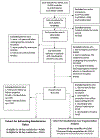Association between readmission care fragmentation and outcomes after interventions for peripheral arterial disease
- PMID: 37657686
- PMCID: PMC11170547
- DOI: 10.1016/j.jvs.2023.08.125
Association between readmission care fragmentation and outcomes after interventions for peripheral arterial disease
Abstract
Objective: Lower extremity revascularization (LER) for peripheral artery disease is complicated by the frequent need for readmission. However, it is unclear if readmission to a nonindex LER facility (ie, a facility different from the one where the LER was performed) compared with the index LER facility is associated with worse outcomes.
Methods: This was a national cohort study of older adults who underwent open, endovascular, or hybrid LER for peripheral artery disease (January 1, 2010, to December 31, 2018) in the Vascular Quality Initiative who were readmitted within 90 days of their vascular procedure. This dataset was linked to Medicare claims and the American Hospital Association Annual Survey. The primary outcome was 90-day mortality and the secondary outcome was major amputation at 90 days after LER. The primary exposure was the location of the first readmission after LER (categorized as occurring at the index LER facility vs a nonindex LER facility). Generalized estimating equations logistic regression models were used to assess the association between readmission location and 90-day mortality and amputation.
Results: Among 42,429 patients who underwent LER, 33.0% were readmitted within 90 days. Of those who were readmitted, 27.3% were readmitted to a nonindex LER facility, and 42.2% of all readmissions were associated with procedure-related complications. Compared with patients readmitted to the index LER facility, those readmitted to a nonindex facility had a lower proportion of procedure-related reasons for readmission (21.5% vs 50.1%; P < .001). Most of the patients readmitted to a nonindex LER facility lived further than 31 miles from the index LER facility (39.2% vs 19.6%; P < .001) and were readmitted to a facility with a total bed size of <250 (60.1% vs 11.9%; P < .001). Readmission to a nonindex LER facility was not associated with 90-day mortality or 90-day amputation. However, readmission for a procedure-related complication was associated with major amputation (90-day amputation: adjusted odds ratio, 3.33; 95% confidence interval, 2.89-3.82).
Conclusions: Readmission after LER for a procedure-related complication is associated with subsequent amputation. This finding suggests that quality improvement efforts should focus on understanding various types of procedure-related failure after LER and its role in limb salvage.
Keywords: Care fragmentation; Peripheral artery disease (PAD); Quality of care; Readmission.
Published by Elsevier Inc.
Conflict of interest statement
Disclosures None.
Comment in
-
Wherever you go, there you are: Readmission location after revascularization.J Vasc Surg. 2023 Dec;78(6):1523. doi: 10.1016/j.jvs.2023.08.126. J Vasc Surg. 2023. PMID: 37981401 No abstract available.
Similar articles
-
Comparison of Rates and Outcomes of Readmission to Index vs Nonindex Hospitals After Major Cancer Surgery.JAMA Surg. 2018 Aug 1;153(8):719-727. doi: 10.1001/jamasurg.2018.0380. JAMA Surg. 2018. PMID: 29641833 Free PMC article.
-
Readmissions to an alternate hospital in patients undergoing vascular intervention for claudication and critical limb ischemia associated with significantly higher mortality.J Vasc Surg. 2019 Dec;70(6):1960-1972. doi: 10.1016/j.jvs.2019.02.055. Epub 2019 May 29. J Vasc Surg. 2019. PMID: 31153697
-
Rapid increase in hybrid surgery for the treatment of peripheral artery disease in the Vascular Quality Initiative database.J Vasc Surg. 2020 Sep;72(3):977-986.e1. doi: 10.1016/j.jvs.2019.11.041. Epub 2020 Feb 14. J Vasc Surg. 2020. PMID: 32067877
-
Readmissions after complex aneurysm repair are frequent, costly, and primarily at nonindex hospitals.J Vasc Surg. 2014 Dec;60(6):1429-37. doi: 10.1016/j.jvs.2014.08.092. Epub 2014 Oct 12. J Vasc Surg. 2014. PMID: 25316154
-
A systematic review and meta-analysis of risk factors for and incidence of 30-day readmission after revascularization for peripheral artery disease.J Vasc Surg. 2019 Sep;70(3):996-1006.e7. doi: 10.1016/j.jvs.2019.01.079. J Vasc Surg. 2019. PMID: 31445653
Cited by
-
Increased market competition is associated with lower mortality after complex aortic surgery.J Vasc Surg. 2025 Sep;82(3):1083-1094.e7. doi: 10.1016/j.jvs.2025.04.032. Epub 2025 Apr 28. J Vasc Surg. 2025. PMID: 40306593
-
Neural network models for predicting readmission among patients undergoing peripheral vascular intervention using electronic health record data and clinical registry data.BMJ Surg Interv Health Technol. 2025 Jun 26;7(1):e000387. doi: 10.1136/bmjsit-2025-000387. eCollection 2025. BMJ Surg Interv Health Technol. 2025. PMID: 40589496 Free PMC article.
References
-
- Fowkes GF, Rudan D, Rudan I, Aboyans V, Denenberg JO, McDermott MM, et al. Comparison of global estimates of prevalence and risk factors for peripheral artery disease in 2000 and 2010: a systematic review and analysis. Lancet 2013;382:1329–40. - PubMed
-
- Vogel TR, Kruse RL. Risk factors for readmission after lower extremity procedures for peripheral artery disease. J Vasc Surg 2013;58:90-7.e1–4. - PubMed
-
- Bundled Payments Care Initiative Advanced. 2022. (Accessed January 28, 2023., 2023, at https://innovation.cms.gov/initiatives/bpci-advanced.)
Publication types
MeSH terms
Grants and funding
LinkOut - more resources
Full Text Sources
Medical


